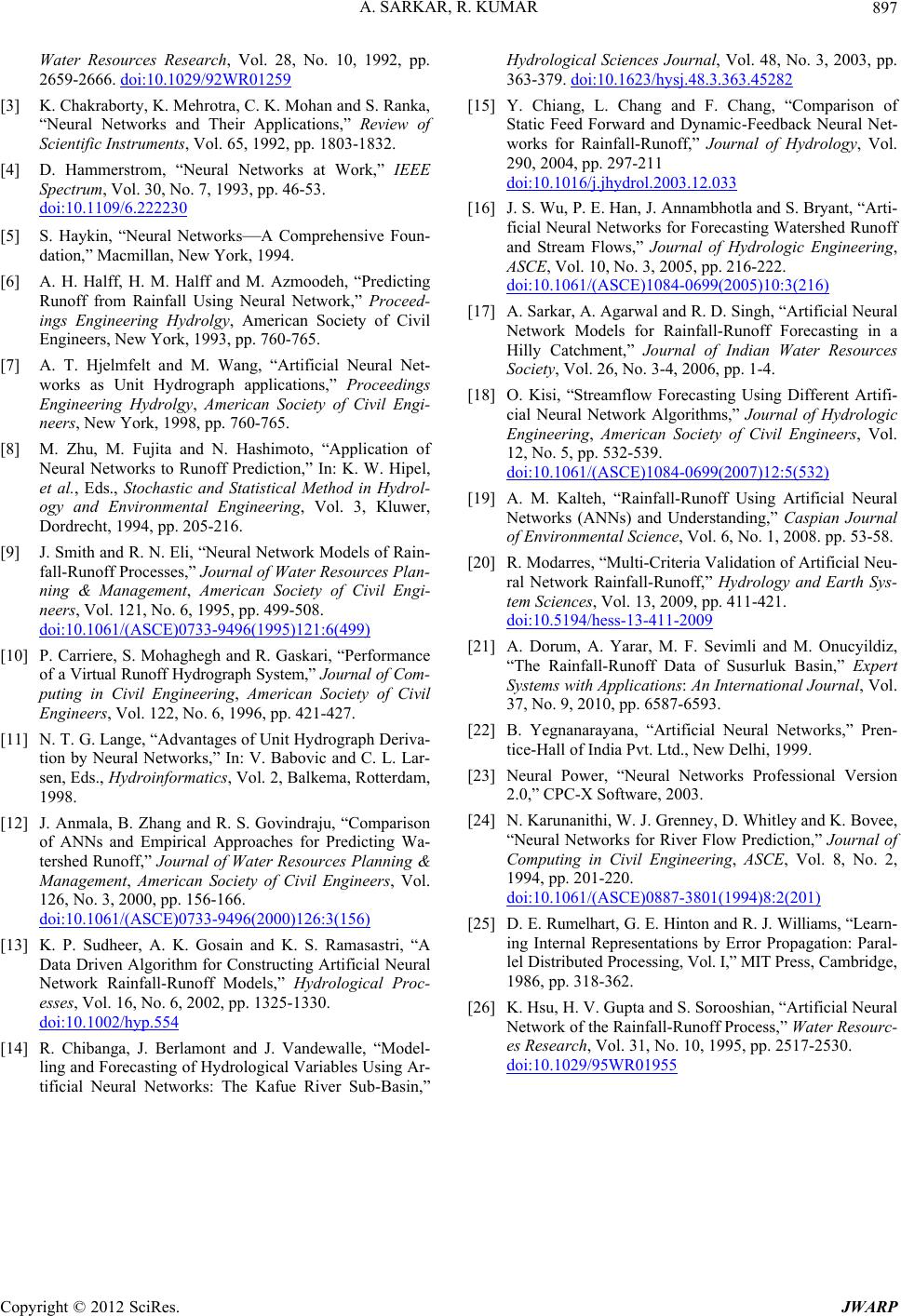
A. SARKAR, R. KUMAR 897
Water Resources Research, Vol. 28, No. 10, 1992, pp.
2659-2666. doi:10.1029/92WR01259
[3] K. Chakraborty, K. Mehrotra, C. K. Mohan and S. Ranka,
“Neural Networks and Their Applications,” Review of
Scientific Instruments, Vol. 65, 1992, pp. 1803-1832.
[4] D. Hammerstrom, “Neural Networks at Work,” IEEE
Spectrum, Vol. 30, No. 7, 1993, pp. 46-53.
doi:10.1109/6.222230
[5] S. Haykin, “Neural Networks—A Comprehensive Foun-
dation,” Macmillan, New York, 1994.
[6] A. H. Halff, H. M. Halff and M. Azmoodeh, “Predicting
Runoff from Rainfall Using Neural Network,” Proceed-
ings Engineering Hydrolgy, American Society of Civil
Engineers, New York, 1993, pp. 760-765.
[7] A. T. Hjelmfelt and M. Wang, “Artificial Neural Net-
works as Unit Hydrograph applications,” Proceedings
Engineering Hydrolgy, American Society of Civil Engi-
neers, New York, 1998, pp. 760-765.
[8] M. Zhu, M. Fujita and N. Hashimoto, “Application of
Neural Networks to Runoff Prediction,” In: K. W. Hipel,
et al., Eds., Stochastic and Statistical Method in Hydrol-
ogy and Environmental Engineering, Vol. 3, Kluwer,
Dordrecht, 1994, pp. 205-216.
[9] J. Smith and R. N. Eli, “Neural Network Models of Rain-
fall-Runoff Processes,” Journal of Water Resources Plan-
ning & Management, American Society of Civil Engi-
neers, Vol. 121, No. 6, 1995, pp. 499-508.
doi:10.1061/(ASCE)0733-9496(1995)121:6(499)
[10] P. Carriere, S. Mohaghegh and R. Gaskari, “Performance
of a Virtual Run off Hydrograph Sy stem,” Journal of Com-
puting in Civil Engineering, American Society of Civil
Engineers, Vol. 122, No. 6, 1996, pp. 421-427.
[11] N. T. G. Lange, “Advantages of Unit Hydrograph Deriva-
tion by Neural Networks,” In: V. Babovic and C. L. Lar-
sen, Eds., Hydroinformatics, Vol. 2, Balkema, Rotterdam,
1998.
[12] J. Anmala, B. Zhang and R. S. Govindraju, “Comparison
of ANNs and Empirical Approaches for Predicting Wa-
tershed Runoff,” Journal of Water Resources Planning &
Management, American Society of Civil Engineers, Vol.
126, No. 3, 2000, pp. 156-166.
doi:10.1061/(ASCE)0733-9496(2000)126:3(156)
[13] K. P. Sudheer, A. K. Gosain and K. S. Ramasastri, “A
Data Driven Algorithm for Constructing Artificial Neural
Network Rainfall-Runoff Models,” Hydrological Proc-
esses, Vol. 16, No. 6, 2002, pp. 1325-1330.
doi:10.1002/hyp.554
[14] R. Chibanga, J. Berlamont and J. Vandewalle, “Model-
ling and Forecasting of Hydrological Variables Using Ar-
tificial Neural Networks: The Kafue River Sub-Basin,”
Hydrological Sciences Journal, Vol. 48, No. 3, 2003, pp.
363-379. doi:10.1623/hysj.48.3.363.45282
[15] Y. Chiang, L. Chang and F. Chang, “Comparison of
Static Feed Forward and Dynamic-Feedback Neural Net-
works for Rainfall-Runoff,” Journal of Hydrology, Vol.
290, 2004, pp. 297-211
doi:10.1016/j.jhydrol.2003.12.033
[16] J. S. Wu, P. E. Han, J. Annambhotla and S. Bryant, “Arti-
ficial Neural Networks for Forecasting Watershed Runoff
and Stream Flows,” Journal of Hydrologic Engineering,
ASCE, Vol. 10, No. 3, 2005, pp. 216-222.
doi:10.1061/(ASCE)1084-0699(2005)10:3(216)
[17] A. Sarkar, A. Agarwal and R. D. Singh, “Artificial Neural
Network Models for Rainfall-Runoff Forecasting in a
Hilly Catchment,” Journal of Indian Water Resources
Society, Vol. 26, No. 3-4, 2006, pp. 1-4.
[18] O. Kisi, “Streamflow Forecasting Using Different Artifi-
cial Neural Network Algorithms,” Journal of Hydrologic
Engineering, American Society of Civil Engineers, Vol.
12, No. 5, pp. 532-539.
doi:10.1061/(ASCE)1084-0699(2007)12:5(532)
[19] A. M. Kalteh, “Rainfall-Runoff Using Artificial Neural
Networks (ANNs) and Understanding,” Caspian Journal
of Environmental Science, Vol. 6, No. 1, 2008. pp. 53-58.
[20] R. Modarres, “Multi-Criteria Validation of Artificial Neu-
ral Network Rainfall-Runoff,” Hydrology and Earth Sys-
tem Sciences, Vol. 13, 2009, pp. 411-421.
doi:10.5194/hess-13-411-2009
[21] A. Dorum, A. Yarar, M. F. Sevimli and M. Onucyildiz,
“The Rainfall-Runoff Data of Susurluk Basin,” Expert
Systems with Applications: An International Journal, Vol.
37, No. 9, 2010, pp. 6587-6593.
[22] B. Yegnanarayana, “Artificial Neural Networks,” Pren-
tice-Hall of India Pvt. Ltd., New Delhi, 1999.
[23] Neural Power, “Neural Networks Professional Version
2.0,” CPC-X Software, 2003.
[24] N. Karunanithi, W. J. Grenney, D. Whitley and K. Bovee,
“Neural Networks for River Flow Prediction,” Journal of
Computing in Civil Engineering, ASCE, Vol. 8, No. 2,
1994, pp. 201-220.
doi:10.1061/(ASCE)0887-3801(1994)8:2(201)
[25] D. E. Rumelhart, G. E. Hinton and R. J. Williams, “Le arn -
ing Internal Representations by Error Propagation: Paral-
lel Distributed Processing, Vol. I ,” MIT Press, Cambridge,
1986, pp. 318-362.
[26] K. Hsu, H. V. Gupta and S. Sorooshian, “Artificial Neural
Network of the Rainfall-Runoff Process,” Water Resourc-
es Research, Vol. 31, No. 10, 1995, pp. 2517-2530.
doi:10.1029/95WR01955
Copyright © 2012 SciRes. JWARP